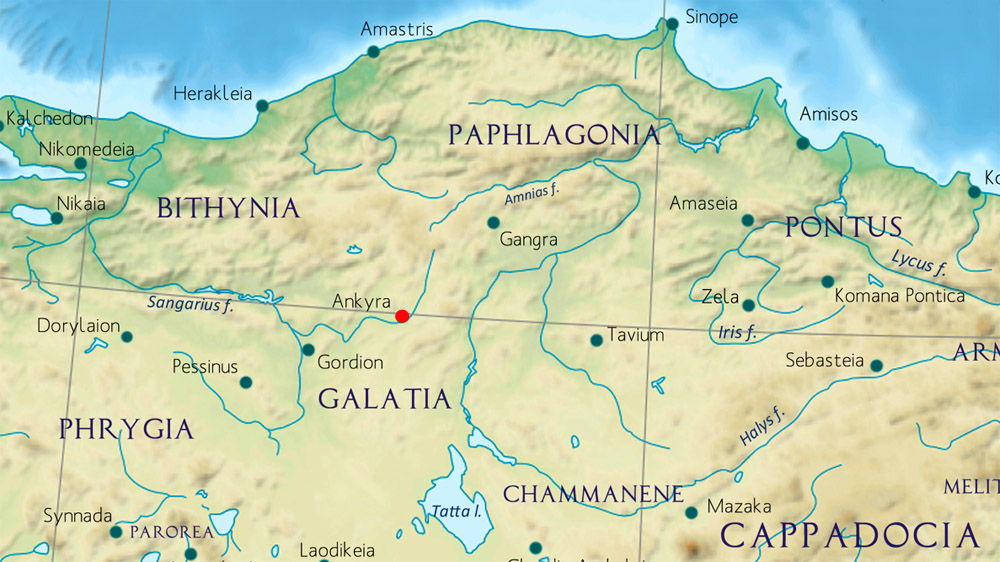Another eagle to add to the convocation - from Ancyra (Ankyra) in Galatia (the modern day Ankara), plus the bonus of Geta as a warrior with spear and shield.
A brief description of the city from The Princeton Encyclopedia of Classical Sites:
Ancyra (Ankara) Galatia, Turkey.
The chief city of the Roman province of Galatia, in central Asia Minor. Its legendary founder was King Midas, but it does not appear in the historical record until the time of Alexander the Great. Until Galatia became a Roman province in 25 B.C., Ancyra remained comparatively insignificant although its commercial importance increased as that of the old Phrygian capital, Gordion, diminished. Throughout the period of the Roman Empire the city flourished, and its importance continued during the Byzantine era when the city was strongly fortified against invasions from the East.
Most of the Roman city has been destroyed by modern Ankara, but some monuments have survived, notably the Temple of Rome and Augustus, the Roman baths and palaestra, and the "Column of Julian."

Regarding the coinage - from Numismatica Hellenica:
Ancyra Galatiae.
Ancyra, the chief town of the Galatae Tectosages, preserves its ancient name, and is still one of the largest and most commercial towns in Asia Minor. Its coins may be distinguished from those of the homonymous city in Phrygia by its name being in the second case singular, while those of the Phrygian city are inscribed ANKYPANON. Its coins are generally imperial, and with the title of Metropolis.
SEBASTE Trocmorum (Tavium).
Note.
Tavium was the chief town of the Trocmi (Strabo). From the coins of Galatia in Mioiinet, it is evident that Ancyra was called Sebaste of the Tectosages, Pessinus was Sebaste of the Tolistobogii, and Tavium, Sebaste of the Trocmi.

Obverse: Laureate draped bust of Geta left, holding spear and shield. Obverse inscription: ΓETAC A(V)ΓO (Geta Augustus). Reverse: Eagle standing left, wings spread, looking back with wreath in its beak. Reverse inscription: MHTPO ANKVPAC (of the metropolis of Ancyra). Bronze. Diameter: 18 mm. Weight: 3.54 gr.
Reference: RPC V.3, — (unassigned; ID 72126)
https://rpc.ashmus.ox.ac.uk/type/72126The "dimples" on this coin raised the old chestnut of what was their purpose? As the other coins in the collection were larger bronzes I had assumed (wrongly) that the dimples only appeared on them, but this Geta coin is fairly small and light and has dimples on both sides. Why do some of the coins have dimples on both sides, while others appear to have a dimple on one side only?
"Centering dimples" does not seem to be an accurate term, as very few are actually in the centre of the flan. It make it highly unlikely that they were made in a turning or lathe type device, and how would the flans have been held? None of the coins in my collection have rotary machining marks evident - anywhere.
The idea of the dimples being made by tongs seems unlikely with many coins having the dimple on one side only. If the blank had to be struck hard with a hammer to impart the die impressions onto the flans, how could the dimples have been made by the tongs? Immense pressure would have to be applied (by hand?) to have the dimples as deep as they are on some examples. As seen on this Geta coin the dimples are not even on the same "centres", so imparting the dimples with tongs would not be possible as the flan would surely flip over.
Another explanation was that a drill type device was used to smooth the surface of the flan prior to striking, but how would such a small flan as this Geta coin have been held in position?
Yet another theory was that the dimples were created after the coin was struck. What would be the point of that?
So many questions, but no apparent correct answer.



























